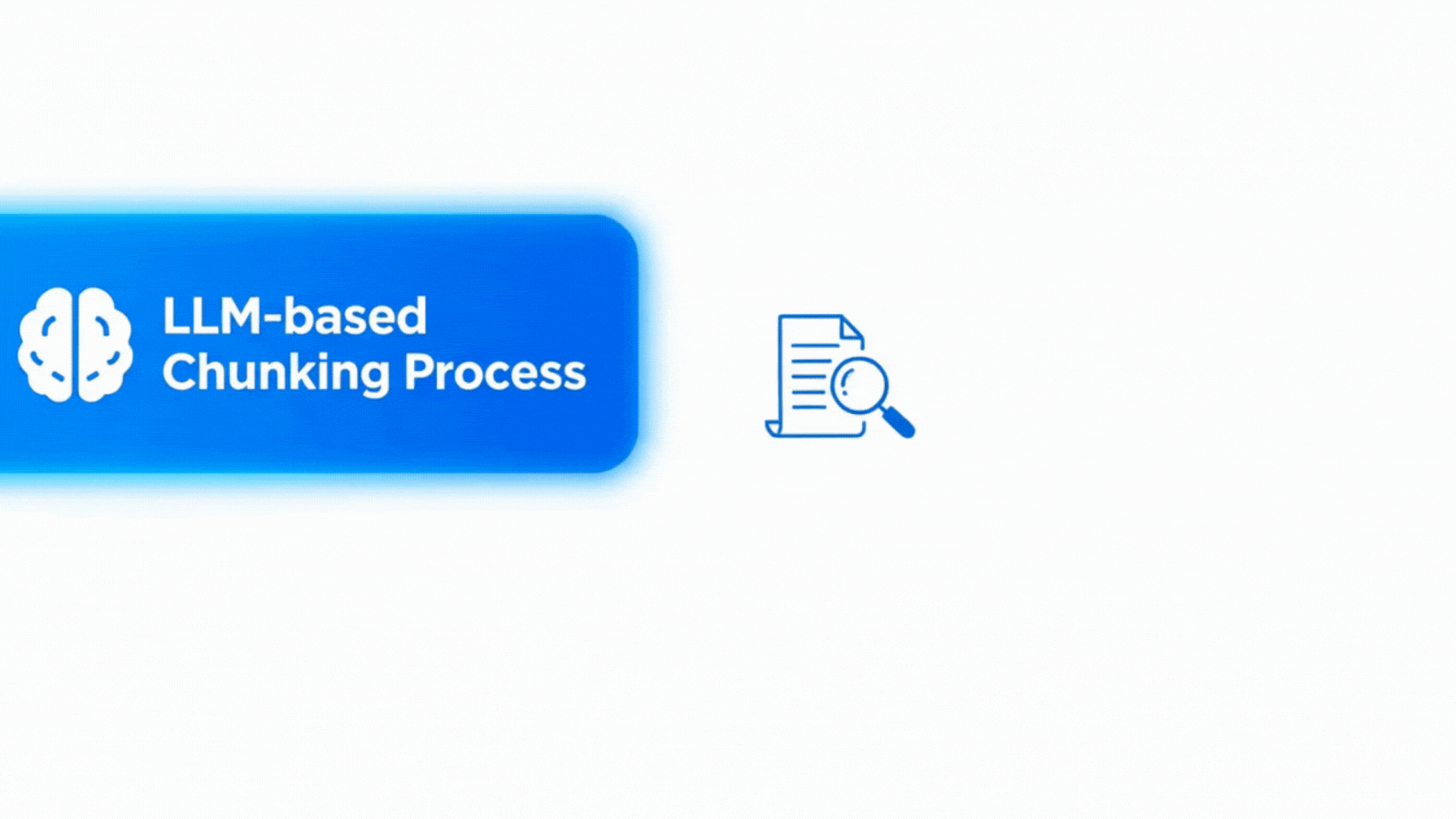
LLM-Based Chunking: Intelligent Text Splitting for Better RAG
So you've got your RAG system up and running. Documents are getting indexed, queries are coming back fast, and those similarity scores look pretty good. Everything seems to be working, right?
Well, not quite.
Here's what I've been noticing lately: users are getting answers, but they're often incomplete and frustrating. Let me give you some examples I've seen:
-
A lawyer searches for "termination clauses in employment contracts" and gets back half a clause - just the consequences, but not the actual conditions that trigger them. Completely useless for legal work.
-
A developer is looking up how API authentication works in our system. They get code snippets, but they're separated from the explanations of why and when to use them. So they're left guessing.
-
And researchers? They search for data collection methodology and get fragments of procedures that don't make sense when taken out of context.
Here's the thing - your vector database is fine. Your language model is doing its job. The real problem is much simpler: we're breaking our documents apart in really dumb ways.
Most of us are still using traditional chunking - split every 500 characters, break at token limits, or just cut at paragraph boundaries. It's like taking a carefully written manual and feeding it through a paper shredder. Sure, all the words are still there, but good luck making sense of them when they're scattered around.
Enter LLM-Based Chunking
This is where things get interesting. What if instead of using these crude splitting methods, we actually had something that could understand the content before deciding where to cut it?
That's exactly what LLM-based chunking does. You feed your document to a language model, and instead of just chopping it up blindly, it actually reads through everything first. Then it makes intelligent decisions about where natural break points should be.
The results are pretty remarkable:
- Each chunk contains complete thoughts and ideas, not random fragments
- Related concepts actually stay together (imagine that!)
- You can even get automatic summaries of what each chunk is about
- Plus metadata that helps with better retrieval later
I like to think of it as the difference between asking a smart intern to organize your files versus just throwing them in a blender. The intern actually reads what's in each document and groups related things together. The blender... well, you get the idea.
How It Works: The Process

So how does this actually work in practice? Let me walk you through what happens when you run a document through LLM-based chunking:
First, it reads the whole thing. Just like you would before trying to organize a long document, the LLM goes through and gets a sense of what the document is actually about. What are the main themes? How is it structured? What's the flow of ideas?
Then it looks for natural break points. Instead of just counting characters or tokens, it's looking for places where it actually makes sense to split things up. Maybe it's the end of a complete thought, or where the author transitions from one topic to another, or where an explanation is fully wrapped up.
Each chunk gets built to stand on its own. This is the really cool part - each piece isn't just a random fragment. It includes enough context that if someone retrieved just that chunk, they'd actually understand what it's talking about. All the supporting details that matter are kept together.
Finally, it adds some helpful extras. The LLM can generate little summaries of what each chunk covers, tag the main topics, and even note how chunks relate to each other. It's like getting a well-organized filing system instead of just a pile of papers.
Traditional vs LLM-Based Chunking: A Quick Comparison
| Aspect | Traditional Methods | LLM-Based Chunking |
|---|---|---|
| Splitting Logic | Fixed rules (character/token count) | Semantic understanding |
| Context Preservation | Often breaks mid-sentence or mid-concept | Maintains complete ideas |
| Processing Speed | Very fast | Slower (requires LLM calls) |
| Cost | Minimal | Higher (LLM API costs) |
| Accuracy | Good for simple content | Excellent for complex documents |
| Customization | Limited rule-based options | Highly adaptable to content type |
Where This Actually Makes a Difference
Let me share some real scenarios where LLM-based chunking solves actual problems:
Legal documents are a perfect example. Think about law firms with thousands of contract templates. With traditional chunking, a search for "termination clauses" often returns half-sentences that are completely useless. You might get "...the employee will forfeit all benefits" but miss the crucial part about when this actually happens. LLM-based chunking keeps entire clauses together, so lawyers get complete, actionable information they can actually use.
Technical documentation is another common pain point. Ever tried to use API docs where the code examples are separated from their explanations? It's incredibly frustrating. This happens all the time - the chunking puts the authentication code in one piece and the "why you need this" explanation somewhere else entirely. LLM-based chunking understands that these pieces belong together.
Research databases have this problem too. Academic institutions often struggle with literature databases that chop up papers in the middle of arguments. Researchers end up getting hypotheses without supporting evidence, or conclusions without methodology. The papers are all there, but they're basically useless for actual research. Smart chunking fixes this by keeping complete arguments intact.
Code Example: Implementing LLM-Based Chunking in TypeScript
Here's a practical example of how you might implement LLM-based chunking using TypeScript:
interface ChunkResult {
content: string;
summary?: string;
topics?: string[];
startIndex: number;
endIndex: number;
}
class LLMChunker {
constructor(private llmClient: any) {}
async chunkDocument(
text: string,
maxChunkSize: number = 1000,
overlap: number = 100
): Promise<ChunkResult[]> {
const prompt = `
Analyze the following text and split it into logical, semantic chunks.
Each chunk should:
1. Contain complete ideas or concepts
2. Be roughly ${maxChunkSize} characters or less
3. Have natural boundaries (don't cut mid-sentence)
4. Include a brief summary of the main points
5. Consider ${overlap} characters of overlap with adjacent chunks for context
Text to chunk:
"""
${text}
"""
Return the result as JSON with this structure:
{
"chunks": [
{
"content": "chunk text here",
"summary": "brief summary",
"topics": ["topic1", "topic2"],
"startIndex": 0,
"endIndex": 250
}
]
}
`;
try {
const response = await this.llmClient.complete({
prompt,
temperature: 0.1, // Low temperature for consistent chunking
maxTokens: 4000,
});
const result = JSON.parse(response.content);
return result.chunks;
} catch (error) {
console.error("LLM chunking failed:", error);
// Fallback to simple chunking
return this.fallbackChunking(text, maxChunkSize, overlap);
}
}
private fallbackChunking(
text: string,
maxSize: number,
overlap: number = 0
): ChunkResult[] {
// Simple fallback implementation with overlap
const chunks: ChunkResult[] = [];
let currentIndex = 0;
while (currentIndex < text.length) {
const endIndex = Math.min(currentIndex + maxSize, text.length);
chunks.push({
content: text.slice(currentIndex, endIndex),
startIndex: currentIndex,
endIndex: endIndex,
});
// Move forward by maxSize minus overlap
currentIndex += Math.max(maxSize - overlap, 1);
}
return chunks;
}
}
// Usage example
const chunker = new LLMChunker(llmClient);
const document = "Your large document text here...";
chunker.chunkDocument(document, 800, 50).then((chunks) => {
chunks.forEach((chunk, index) => {
console.log(`Chunk ${index + 1}:`);
console.log(`Content: ${chunk.content.substring(0, 100)}...`);
console.log(`Summary: ${chunk.summary}`);
console.log(`Topics: ${chunk.topics?.join(", ")}`);
console.log("---");
});
});
When Should You Actually Use This?
Look, LLM-based chunking isn't a magic bullet for everything. Here's when it's actually worth the extra effort and cost:
Use it when context really matters. If you're dealing with legal documents, medical records, technical manuals, or research papers - basically anything where breaking up related information would make it useless - then yes, absolutely go for it. The improved accuracy will be worth the extra cost.
Use it when getting the right answer is more important than getting it fast. If your users would rather wait an extra second to get a complete, accurate response instead of getting fragments quickly, this is your tool.
Use it for specialized content. Industry-specific documents, academic papers, complex procedures - anything that requires understanding of how concepts relate to each other.
But skip it if you're dealing with simple stuff. Product catalogs, basic FAQs, straightforward documentation - traditional chunking is probably fine for these. Don't overcomplicate things.
Also skip it if you need lightning-fast responses or you're processing massive volumes where every API call adds up cost-wise. Sometimes "good enough" really is good enough.
How to Get Started
If you want to try this out, here's what generally works best:
Start small. Don't try to migrate your entire document collection at once. Pick maybe 50-100 of your most problematic documents - the ones where users complain about getting incomplete answers. Run those through LLM-based chunking first.
Do a side-by-side comparison. Take the same documents, chunk them both ways, and see what happens. Ask a few people to try searching and see which results they prefer. The difference is usually pretty obvious.
Actually measure the impact. I know, measuring stuff is boring, but it matters. Track things like: Are users getting the answers they need? Are they having to do follow-up searches less often? Are support tickets going down?
Don't try to perfect it immediately. Start with basic prompts and see how it goes. You can always fine-tune later once you understand how it behaves with your specific content.
The main thing is finding the sweet spot between getting better results and not breaking your budget on API calls.
Or Just Use IngestIQ
Look, if all this sounds interesting but you don't want to spend months building it yourself, we've actually built exactly this into IngestIQ. It's our RAG platform that handles all the chunking stuff I've been talking about.
Here's why we built it:
Because setting up RAG infrastructure takes forever. Instead of spending months building document processing pipelines, you can get intelligent chunking working in hours.
Because writing good chunking prompts is harder than it looks. We've already done the work of figuring out what prompts actually work well for different types of content.
Because you probably want to connect to your existing data sources. We've got connectors for Google Drive, S3, Confluence, Slack - basically wherever your documents live.
Because you need this to work with your existing systems. We provide both traditional APIs and direct MCP endpoints, so you can plug it into whatever agents or applications you're building.
Because manual indexing is a pain. Everything stays in sync automatically.
Basically, it's all the stuff that would make implementing this much easier.
If you want to check it out: IngestIQ →
Questions? Email us at hello@avestalabs.ai

AI Engineer with a product mindset who transforms complex technical challenges into user-focused solutions. With 5+ years in software engineering and expertise in AI systems, I specialize in building intelligent applications that solve real-world problems.


